9 Roles Of The President
Chief Executive
Chief Executive is a term commonly used to refer to Presidential powers given by the Constitution.
Learning Objectives
Place the nature of the powers granted to the President in Commodity Two of the Constitution
Key Takeaways
Key Points
- The president has many official and unofficial roles. The formal powers and duties of the president are outlined in Article Ii of the Constitution.
- As Chief Executive the president can: implement policy, supervise the executive co-operative of regime, prepare executive budget for submission to congress, and appoint and remove executive officials.
- The head of regime is the chief officer of the executive branch of a authorities, ofttimes presiding over a cabinet. In presidential republics or accented monarchies, the head of government may exist the same person as the head of land, who is ofttimes likewise called a president or a monarch.
Key Terms
- head of regime: The chief officer of the executive branch of a government, often presiding over a chiffonier; usually called Prime Minister (in a parliamentary arrangement) or President (in a presidential system).
- chief executive: The president of the Us.
Introduction
The president has many official and unofficial roles. The formal powers and duties of the president are outlined in Article 2 of the Constitution. Although the Constitution grants far fewer explicit powers to the president in Article 2 than it does to Congress in Article I, the ambiguity and vagueness of Article II take made it possible for presidents to expand their authority greatly across that specifically listed in the Constitution. The two passages in the Constitution that have provided the basis for the expansion of presidential authorization are Article II, Section i, which grants "the executive Power" to the president, and Section three, which makes the president responsible for the enforcement of federal laws: "He shall have Care that the Laws be faithfully executed." Equally a consequence, "unofficial" presidential roles accept evolved through both history and tradition.
Every bit Chief Executive
Chief Executive is a term used for certain gubernatorial offices, expressing the nature of their job being analogous to a head of government. It is normally used to refer to Presidential powers given by the constitution. As Chief Executive the president can: implement policy, supervise the executive branch of regime, gear up an executive budget for submission to congress, and appoint and remove executive officials.
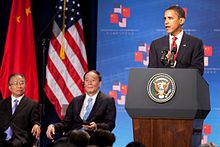
Obama Administration and Foreign Policy: President Barack Obama acts equally the principal executive of the federal government of the The states.
Equally Head of Government
Head of government is the chief officer of the executive branch of a regime, frequently presiding over a cabinet. In a parliamentary system, the head of regime is often styled prime minister, master minister, premier, etc. In presidential republics or absolute monarchies, the head of government may be the same person every bit the head of state, who is often also chosen a president or a monarch.
In a parliamentary system, the head of state is normally a different person from the head of regime. This is in contrast to a presidential arrangement in a democracy, where the head of country often is as well the head of government, and well-nigh importantly: the executive branch does not derive its democratic legitimacy from the legislature. The Parliamentary system can be assorted with a presidential system which operates under a stricter separation of powers, whereby the executive does not form part of, nor is appointed by, the parliamentary or legislative body. In such a system, congresses exercise not select or dismiss heads of governments, and governments cannot request an early dissolution as may be the case for parliaments. Since the legislative branch has more power over the executive branch in a parliamentary system, a notable amount of studies by political scientists have shown that parliamentary systems testify lower levels of abuse than presidential systems of authorities.
Commander-in-Chief
A commander-in-master is the person exercising supreme command say-so of a nation's military forces; in the United states, this person is the president.
Learning Objectives
Explain the President's position as commander-in-main
Key Takeaways
Key Points
- Civilian control of the military is a doctrine in military and political science that places ultimate responsibility for a state's strategic controlling in the hands of the civilian political leadership, rather than professional military officers.
- The current commander-in-chief of the United States Armed Forces is Barack Obama, the 44th person to hold the position since Grover Cleveland served two non- sequent terms equally President of the U.s..
- Since 1949, the Secretary of Defense, a civil officer appointed past the President with the advice and consent of the Senate, is past statute second in command over those armed forces which are part of the Department of Defence: the Army, Navy, Air Forcefulness, and the Marine Corps.
- The Chairman of the Joint Chiefs of Staff, the U.South. chief of defense force equivalent, may assist the President and Secretary of Defense in the exercise of their command functions, but the Chairman himself does not independently exercise command over whatsoever combatant forces.
Key Terms
- commander-in-chief: A commander-in-chief is the person exercising supreme command authority over a nation'due south military forces or pregnant element of those forces.
- civilian control of the military: Civilian command of the military is a doctrine in military and political science that places ultimate responsibility for a land'due south strategic decision-making in the hands of the civilian political leadership, rather than professional military machine officers.
- chairman of the articulation chiefs of staff: The Chairman of the Joint Chiefs of Staff, the U.S. primary of defence force equivalent, may assist the President and Secretary of Defense force in the do of their control functions, but the Chairman himself does non independently exercise control over any combatant forces.
Introduction
A commander-in-chief is the person exercising supreme command authority of a nation's military forces or significant element of those forces. As a practical term it refers to the military machine competencies that reside in a nation-country's executive, Head of State and/or Head of Government. Often, a given country's commander-in-chief need not exist or have been a commissioned officer or even a veteran, and it is by this legal statute that noncombatant control of the military is realized in states where it is constitutionally required. Noncombatant control of the armed forces is a doctrine in military machine and political scientific discipline that places ultimate responsibility for a country's strategic controlling in the easily of the civilian political leadership, rather than professional armed services officers.
According to Commodity Two, Section two, Clause I of the Constitution, the President of the United States is commander-in-chief of the Us Armed Forces. The current commander-in-principal of the United states Armed forces is Barack Obama, the 44th person to hold the position since Grover Cleveland served two not consecutive terms equally President of the United states.
U.Southward. President equally Commander in Master
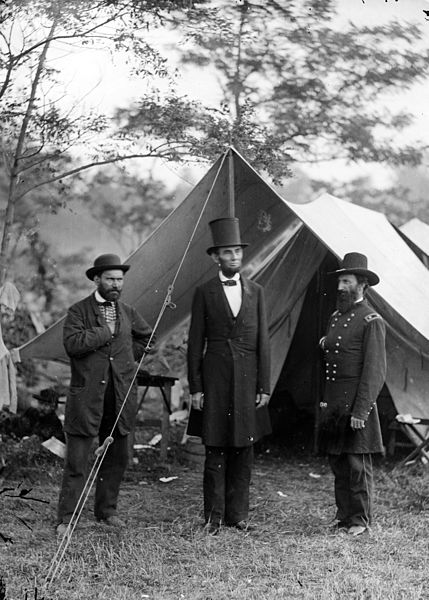 President Abraham Lincoln as Commander-in-Chief: President Abraham Lincoln, as commander-in-primary of the United states of america War machine, with Allan Pinkerton and Major General John A. McClernand subsequently the Battle of Antietam, 1862.
President Abraham Lincoln as Commander-in-Chief: President Abraham Lincoln, as commander-in-primary of the United states of america War machine, with Allan Pinkerton and Major General John A. McClernand subsequently the Battle of Antietam, 1862.
The amount of military detail handled past the President in wartime has varied dramatically. Abraham Lincoln was deeply involved in overall strategy and in day-to-twenty-four hours operations during the American Civil War, 1861–1865; historians have given Lincoln high praise for his strategic sense and his power to select and encourage commanders such as Ulysses Due south. Grant.
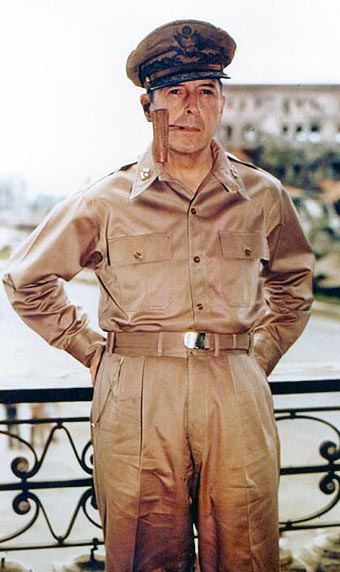 Douglas MacArthur in Manila: An immensely popular hero of Globe State of war II, General Douglas MacArthur's public insistence on the need to aggrandize the Korean War, over the objections of President Harry S. Truman, led to the termination of his command.
Douglas MacArthur in Manila: An immensely popular hero of Globe State of war II, General Douglas MacArthur's public insistence on the need to aggrandize the Korean War, over the objections of President Harry S. Truman, led to the termination of his command.
On the other paw, Woodrow Wilson paid very petty attention to operational armed services details of World War I and had very little contact with General John J. Pershing, who allowable the armies in the field. As President throughout much of Globe State of war II, Franklin D. Roosevelt, on the domestic front, used his fireside chats and the press to explain and justify his hard wartime decisions away. Harry Due south. Truman believed in a high amount of civilian leadership of the military, making many tactical and policy decisions based on the recommendations of his advisors— including the decision to use nuclear weapons on Nippon, to commit American forces in the Korean War, and to terminate Douglas MacArthur from his command.
Secretarial assistant of Defense
Since 1949, the Secretarial assistant of Defense force, a civil officeholder appointed by the President with the advice and consent of the Senate, is by statute second in command over those armed forces which are part of the Department of Defense: the Army, Navy, Air Force, and the Marine Corps. The operational co-operative of the chain of command runs from the President to the Secretary of Defense, and from the Secretary of Defense down to the combatant commanders of the unified combatant commands. The Chairman of the Joint Chiefs of Staff, the U.S. main of defence equivalent, may assistance the President and Secretarial assistant of Defence force in the exercise of their command functions, but the Chairman himself does non independently exercise command over whatsoever combatant forces.
Head of State
The President of the United States of America is the head of country and head of regime of the United States.
Learning Objectives
Summarize the various roles performed by the President as Head of Country
Fundamental Takeaways
Primal Points
- Head of State is a term used in constitutional police, international constabulary, political scientific discipline, and diplomatic protocol to designate an official who holds the highest ranked position in a land. This official has the vested or implied powers to act every bit the chief public representative of a sovereign land.
- A presidential system is a system of regime where an executive branch is led by a president who serves as both head of state and head of regime. In such a system, this branch exists separately from the legislature, to which it is not responsible and which it cannot dismiss.
- In presidential systems, such equally that of the United states, appointments are nominated at the President's sole discretion, but this nomination is ofttimes subject to parliamentary confirmation.
- In presidential systems the head of state often formally reports to the legislature on the present national condition, equally in the Country of the Spousal relationship address in the United states of america.
Cardinal Terms
- head of country: The chief public representative of a nation having duties, privileges and responsibilities varying greatly depending on the constitutional rules; a monarch in a monarchy, and often styled president in a republic, but variations such equally collegiality exist.
- presidential organization: A presidential arrangement is a arrangement of authorities where an executive co-operative is led by a president who serves as both head of state and caput of authorities. In such a arrangement, this branch exists separately from the legislature, to which it is non responsible and which information technology cannot, in normal circumstances, dismiss.
Introduction
The President of the Usa of America is the head of country and head of government of the United States. The president leads the executive branch of the federal government and is the commander-in-principal of the United States Armed forces. Head of Land is a term used in constitutional police force, international police force, political science, and diplomatic protocol to designate an official who holds the highest ranked position in a state and has the vested or implied powers to act as the chief public representative of a sovereign state. Heads of country in most countries are natural persons belongings an office, however in some countries the head of state position is held by a body of persons.

Earth Head of States 1889: "The World's Sovereigns": A photo montage fabricated in Europe in 1889 with the principal heads of state in the world. As head of state, it is the chore of each of these leaders to represent their countries.
A presidential organization is a organization of government where an executive branch is led by a president who serves as both head of state and head of government. In such a system, this branch exists separately from the legislature, to which it is not responsible and which it cannot, in normal circumstances, dismiss. Presidential systems are a notable characteristic of constitutions in the Americas, including those of the Argentina, Brazil, Colombia, El salvador, Mexico and Venezuela; this is generally attributed to the potent influence of the United States in the region, and equally the United States Constitution served equally an inspiration and model for the Latin American wars of independence of the early xixth century.
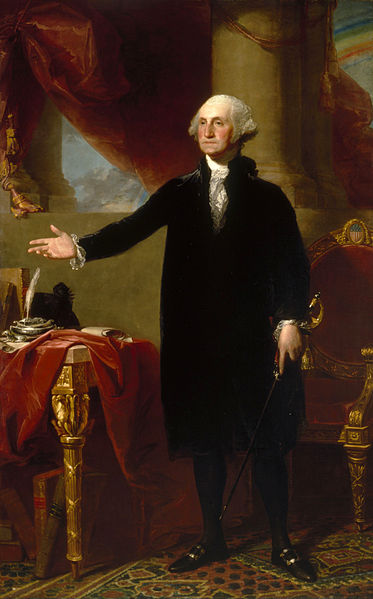
George Washington: George Washington, the first President of the Usa, set the precedent for an executive caput of state in republican systems of government.
Presidential governments brand no distinction betwixt the positions of head of country and head of government, both of which are held past the president. Many parliamentary governments have a symbolic head of country in the form of a president or monarch. That person is responsible for the formalities of state functions, or in cases where the head of country has reserve powers, the "hands off" ensuing of a functional parliament, while the constitutional prerogatives of head of government are mostly exercised by the prime minister.
Caput of Land in the Usa
In the 1870s, in the aftermath of the impeachment of President Andrew Johnson and his most-removal from role, it was speculated that the United States, likewise, would move from a presidential organization to a semi-presidential or fifty-fifty parliamentary 1. Under this new system, the Speaker of the House of Representatives would become the real middle of government every bit a quasi-prime minister. This did not in fact happen. The presidency, having been damaged by iii late nineteenth and early twentieth century assassinations, and one impeachment, reasserted its political dominance past the early twentieth century through such figures as Theodore Roosevelt and Woodrow Wilson.
In presidential systems, such every bit that of the Us, appointments are nominated by the President'due south sole discretion, just this nomination is ofttimes subject to parliamentary confirmation (in the case of the Us, the Senate has to approve chiffonier nominees and judicial appointments by unproblematic majority). Moreover, in presidential systems, the president often has the power to burn ministers at his sole discretion. In the The states, convention calls for cabinet secretaries to resign on their own initiative when called to practice so.
Legislative Roles
It is usual that the head of state, particularly in parliamentary systems as part of the symbolic role, is the one who opens the annual sessions of the legislature, e.g. the annual State Opening of Parliament with the Speech from the Throne in Britain. Fifty-fifty in presidential systems the head of state ofttimes formally reports to the legislature on the present national status, e.g. the State of the Union address in the United states.
Ceremonial Roles
As head of state, the president tin can fulfill traditions established past previous presidents. William Howard Taft started the tradition of throwing out the formalism first pitch in 1910 at Griffith Stadium, Washington, D.C., on the Washington Senators' Opening Day. Every president since Taft, except for Jimmy Carter, threw out at to the lowest degree i ceremonial first ball or pitch for Opening Solar day, the All-Star Game, or the Earth Series, usually with much fanfare.
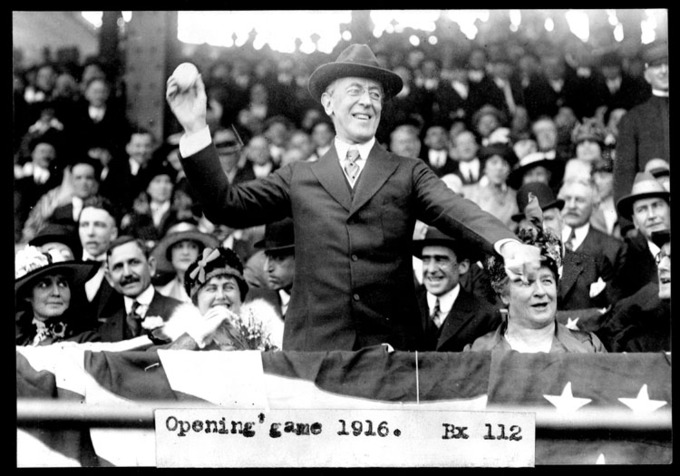
Wilson opening day 1916: U.Southward. President Woodrow Wilson throws out the ball on opening day of baseball season, 1916.
During a state visit past a foreign head of state, the president typically hosts a State Arrival Ceremony held on the South Lawn, a custom begun past John F. Kennedy in 1961. This is followed by a country dinner given by the president which is held in the State Dining Room after in the evening.
Master Diplomat
The appointment power of the President allows him or her to appoint and receive ambassadors effectually the world.
Learning Objectives
Explain the President'due south role as chief diplomat
Key Takeaways
Cardinal Points
- Affairs is the art and practice of conducting negotiations between representatives of groups or states. In an informal or social sense, diplomacy is the employment of tact to gain strategic advantage or to discover mutually acceptable solutions to a mutual challenge.
- The President is the nation'due south chief diplomat; they accept the power brand treaties that are then subject field to ratification by the Senate.
- It is generally accepted that they have the President has the power every bit a result of their ramble authority to "send and receive ambassadors. " This is generally known as the " appointment ability " of the presidency.
- Along with naming judges, presidents appoint ambassadors and executive officers. If Congress is not in session, presidents tin brand temporary appointments known equally recess appointments without Senate confirmation, good until the end of the next session of Congress.
Key Terms
- diplomacy: The art and practise of conducting international relations by negotiating alliances, treaties, agreements, etc., bilaterally or multilaterally, between states and sometimes international organizations or even between policies with varying statuses, such every bit those of monarchs and their princely vassals.
- appointment power: The date ability of the presidency refers to the president's constitutional authorization to appoint and receive ambassadors to and from other countries.
- recess appointments: Along with naming judges, presidents engage ambassadors and executive officers. These appointments crave Senate confirmation. If Congress is not in session, presidents can make temporary appointments known as recess appointments without Senate confirmation, good until the end of the side by side session of Congress.
Introduction
Diplomacy is the art and practice of conducting negotiations between representatives of groups or states. It commonly refers to international affairs, the acquit of international relations through the intercession of professional diplomats with regard to issues of peacemaking, merchandise, war, economics, culture, environment and homo rights. International treaties are usually negotiated by diplomats prior to endorsement by national politicians. In an breezy or social sense, diplomacy is the employment of tact to gain strategic advantage or to observe mutually acceptable solutions to a common claiming, ane fix of tools beingness the phrasing of statements in a nonconfrontational, or polite way.
U.South. President equally Chief Diplomat
Although the Constitution does not explicitly grant presidents the power to recognize foreign governments, it is by and large accepted that they have this power as a result of their constitutional potency to "send and receive ambassadors. " This is generally known as the "date power" of the presidency. Considering the acts of sending an ambassador to a country and receiving its representative imply recognition of the legitimacy of the foreign authorities involved, presidents have successfully claimed exclusive authority to make up one's mind which foreign governments are recognized by the U.s.a.. It follows, then, that they have the power to stop relations with other nations equally well.
Forth with naming judges, presidents appoint ambassadors and executive officers. These appointments require Senate confirmation. If Congress is not in session, presidents can make temporary appointments known as recess appointments without Senate confirmation, expert until the end of the next session of Congress.
Although non constitutionally provided, presidents also sometimes use " executive agreements " in foreign relations. These agreements oftentimes regard administrative policy choices germane to executive power; for case, the extent to which either country presents an armed presence in a given area, how each country will enforce copyright treaties, or how each country will process foreign mail. Notwithstanding, the 20th century witnessed a vast expansion of the use of executive agreements, and critics have challenged the extent of that apply as supplanting the treaty procedure and removing constitutionally prescribed checks and balances over the executive in foreign relations. Supporters counter that the agreements offer a pragmatic solution when the need for swift, secret, and/or concerted action arises.
Breezy Diplomacy
Informal affairs has been used for centuries to communicate between powers. Almost diplomats piece of work to recruit figures in other nations who might exist able to give informal access to a country's leadership. On some occasion a quondam holder of an official position continues to behave out an informal diplomatic activity afterward retirement. In some cases, governments welcome such activeness, for example as a ways of establishing an initial contact with a hostile state of group without being formally committed. In other cases, nonetheless, such informal diplomats seek to promote a political agenda different from that of the regime currently in power. Such informal diplomacy is practiced by sometime US Presidents Jimmy Carter and (to a lesser extent) Beak Clinton and by the former Israeli diplomat and minister Yossi Beilin.

James Carter Presidential Portrait: Jimmy Carter served as the thirty-ninth President of the Usa from 1977 to 1981.
Primary Legislator
Every bit chief legislator, the president may suggest, asking, and insist that Congress enact laws he believes are needed.
Learning Objectives
Appraise the significance of the Line Detail Veto for executive power
Key Takeaways
Key Points
- As primary legislator, the president shapes policy. The Constitution is reticent well-nigh the president'southward role in legislating, yet the human relationship between Congress and the executive is the most important attribute of the U.Southward. system of regime.
- The president may suggest, request, and insist that Congress enact laws he believes are needed. He can effort to influence Congress through promises of patronage and favors.
- In 1996, Congress attempted to enhance the president'southward veto power with the Line Item Veto Human action. The legislation empowered the president to sign any spending bill into police force while simultaneously striking certain spending items within the beak.
- In Clinton five. Metropolis of New York (1998), the U.S. Supreme Court ruled such a legislative alteration of the veto ability to be unconstitutional.
Key Terms
- line particular veto act: The Line Particular Veto Human activity of 1996 enacted a line-particular veto for the Federal regime of the United States, but its effect was brief because the act was overturned after judicial review.
- clinton five. metropolis of new york: In Clinton v. City of New York (1998), the U.Due south. Supreme Court ruled the Line Detail Veto Act'south expansion of veto ability to be unconstitutional.
- veto: A political correct to disapprove of (and thereby cease) the process of a decision, a law, etc.
- pocket veto: a legislative maneuver in lawmaking that allows a president or other official to unilaterally stop a bill by taking no action
Primary Legislator
The president has many official and unofficial roles. The formal powers and duties of the president are outlined in Article Two of the Constitution. Equally master legislator, the president shapes policy. The Constitution is reticent about the president's role in legislating, withal the relationship betwixt Congress and the executive is the about of import aspect of the U.Due south. system of government. The president tin gather information from the hierarchy, present a legislative calendar to Congress, and get to the American public for support for his legislative agenda.
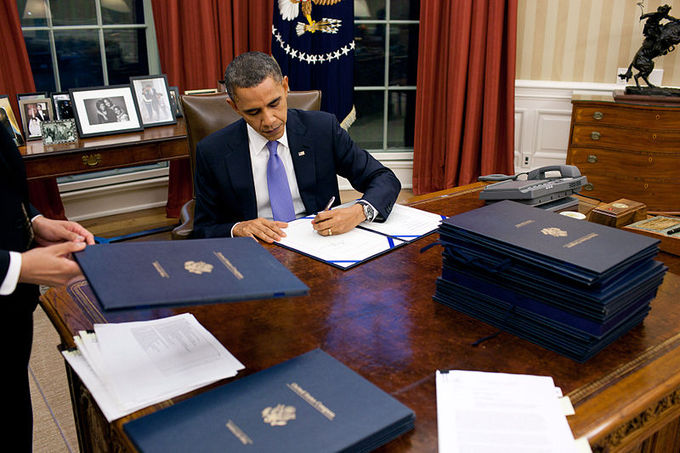
President Barack Obama Signing Legislation: President Barack Obama signs legislation in the Oval Office, December. 22, 2010. (Official White Business firm Photo by Pete Souza)
The president may suggest and request that Congress enact laws he believes are needed. He tin attempt to influence Congress through promises of patronage and favors. He stays in touch on with Congress formally through written messages and informally through private meetings, parties, and phone calls. When the president receives legislation, he decides whether to veto it, use the pocket veto, sign it, or practise nix. If the president does nothing, and so if Congress is still in session ten days after it becomes law.
In 1996, Congress attempted to enhance the president's veto ability with the Line Item Veto Act. The legislation empowered the president to sign whatever spending bill into law while simultaneously hit certain spending items inside the bill, particularly any new spending, any corporeality of discretionary spending, or whatsoever new limited taxation do good. Once a president had stricken the particular, Congress could pass that particular item again. If the president then vetoed the new legislation, Congress could override the veto by the ordinary method of a two-thirds vote in both houses. In Clinton v. City of New York (1998), the U.Due south. Supreme Courtroom ruled such a legislative amending of the veto ability to be unconstitutional.
Political Party Leader
The president is largely responsible for dictating the legislative calendar of his party.
Learning Objectives
Draw roles that the President plays above and beyond serving as the nation's chief executive
Key Takeaways
Key Points
- The Constitution 's Ineligibility Clause prevents the president from simultaneously beingness a member of Congress. Therefore, the president cannot direct introduce legislative proposals for consideration in Congress.
- Withal, the president can take an indirect function in shaping legislation, particularly if the president's political political party has a majority in ane or both houses of Congress.
- The modernistic presidential campaign begins before the main elections, which the two major political parties employ to clear the field of candidates before their national nominating conventions, where the most successful candidate is made the party's nominee for president.
Fundamental Terms
- ineligibility clause: The Constitution's Ineligibility Clause prevents the president from simultaneously existence a member of Congress. Therefore, the president cannot direct introduce legislative proposals for consideration in Congress.
Introduction
The President of the United States of America is the caput of land and caput of government of the United States. The president leads the executive branch of the federal government and is the commander-in-master of the U.s.a. Military. Since the founding of the United States, the power of the president and the federal government have grown substantially, and each modern president, despite possessing no formal legislative powers beyond signing or vetoing congressionally passed bills, is largely responsible for dictating the legislative agenda of his party and the strange and domestic policy of the Usa.
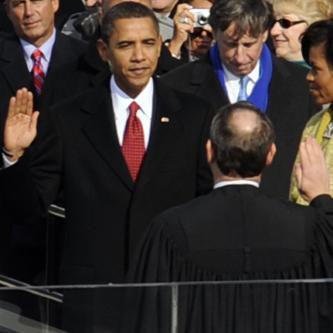
Obama Taking Oath of Office: After winning the 2008 presidential election, Barack Obama was sworn into role on January xx, 2009.
Every bit Legislative Facilitator
The Constitution's Ineligibility Clause prevents the president from simultaneously being a member of Congress. Therefore, the president cannot directly introduce legislative proposals for consideration in Congress. However, the president can take an indirect office in shaping legislation, particularly if the president's political party has a majority in one or both houses of Congress. For example, the president or other officials of the executive branch may draft legislation and so ask senators or representatives to introduce these drafts into Congress. The president can further influence the legislative co-operative through constitutionally mandated, periodic reports to Congress. These reports may be either written or oral, but today are given as the State of the Matrimony Accost, which often outlines the president's legislative proposals for the coming year.
Campaigns and Nomination
The mod presidential campaign begins before the primary elections, which the two major political parties use to clear the field of candidates earlier their national nominating conventions, where the nearly successful candidate is made the party's nominee for president. Typically, the party'due south presidential candidate chooses a vice presidential nominee, and this choice is rubber stamped by the convention. Nominees participate in nationally televised debates, and while the debates are commonly restricted to the Autonomous and Republican nominees, third party candidates may be invited, such as Ross Perot in the 1992 debates. Nominees campaign across the country to explicate their views, convince voters, and solicit contributions. Much of the mod electoral process is concerned with winning swing states through frequent visits and mass media advertising drives.
Licenses and Attributions
CC licensed content, Shared previously
- Curation and Revision. Provided by: Boundless.com. License: CC BY-SA: Attribution-ShareAlike
CC licensed content, Specific attribution
- POLSC332: Cess #4: u201cThe Formal and Informal Roles of the Presidentu201d. Provided by: Saylor. Located at: https://resource.saylor.org/wwwresources/archived/site/wp-content/uploads/2011/10/POLSC332-Assessment4-Terminal.pdf. License: CC BY: Attribution
- Caput of government. Provided by: Wikipedia. License: CC By-SA: Attribution-ShareAlike
- Primary executive (gubernatorial). Provided by: Wikipedia. License: CC By-SA: Attribution-ShareAlike
- Parliamentary arrangement. Provided by: Wikipedia. License: CC BY-SA: Attribution-ShareAlike
- chief executive. Provided by: Wiktionary. License: CC BY-SA: Attribution-ShareAlike
- head of government. Provided by: Wiktionary. License: CC BY-SA: Attribution-ShareAlike
- Foreign policy of the Barack Obama administration. Provided by: Wikipedia. License: Public Domain: No Known Copyright
- Commander-in-chief. Provided by: Wikipedia. License: CC Past-SA: Attribution-ShareAlike
- Civilian control of the military. Provided by: Wikipedia. License: CC By-SA: Attribution-ShareAlike
- chairman of the articulation chiefs of staff. Provided by: Wikipedia. License: CC Past-SA: Attribution-ShareAlike
- commander-in-chief. Provided by: Wikipedia. License: CC Past-SA: Attribution-ShareAlike
- civilian control of the armed forces. Provided by: Wikipedia. License: CC BY-SA: Attribution-ShareAlike
- Foreign policy of the Barack Obama administration. Provided by: Wikipedia. License: Public Domain: No Known Copyright
- MacArthur Manila. Provided by: Wikipedia. Located at: https://en.wikipedia.org/wiki/File:MacArthur_Manila.jpg. License: Public Domain: No Known Copyright
- PinkertonLincolnMcClernand. Provided by: Wikipedia. License: Public Domain: No Known Copyright
- President of the Us. Provided by: Wikipedia. License: CC By-SA: Attribution-ShareAlike
- Presidential system. Provided by: Wikipedia. License: CC Past-SA: Attribution-ShareAlike
- Head of state. Provided past: Wikipedia. License: CC BY-SA: Attribution-ShareAlike
- presidential system. Provided by: Wikipedia. License: CC By-SA: Attribution-ShareAlike
- caput of land. Provided by: Wiktionary. License: CC BY-SA: Attribution-ShareAlike
- Foreign policy of the Barack Obama assistants. Provided by: Wikipedia. License: Public Domain: No Known Copyright
- MacArthur Manila. Provided by: Wikipedia. License: Public Domain: No Known Copyright
- PinkertonLincolnMcClernand. Provided past: Wikipedia. License: Public Domain: No Known Copyright
- Wilson opening day 1916. Provided by: Wikipedia. License: Public Domain: No Known Copyright
- World caput of states in 1889. Provided by: Wikipedia. License: Public Domain: No Known Copyright
- Gilbert Stuart, George Washington (Lansdowne portrait, 1796). Provided by: Wikipedia. License: Public Domain: No Known Copyright
- POLSC332: Assessment #4: u201cThe Formal and Informal Roles of the Presidentu201d. Provided past: Saylor. Located at: https://resource.saylor.org/wwwresources/archived/site/wp-content/uploads/2011/10/POLSC332-Assessment4-FINAL.pdf. License: CC Past: Attribution
- President of the Usa. Provided past: Wikipedia. License: CC By-SA: Attribution-ShareAlike
- Chief diplomat. Provided by: Wikipedia. License: CC BY-SA: Attribution-ShareAlike
- recess appointments. Provided by: Wikipedia. License: CC By-SA: Attribution-ShareAlike
- diplomacy. Provided by: Wiktionary. License: CC By-SA: Attribution-ShareAlike
- appointment power. Provided by: Wikipedia. License: CC Past-SA: Attribution-ShareAlike
- Strange policy of the Barack Obama administration. Provided past: Wikipedia. License: Public Domain: No Known Copyright
- MacArthur Manila. Provided by: Wikipedia. License: Public Domain: No Known Copyright
- PinkertonLincolnMcClernand. Provided by: Wikipedia. License: Public Domain: No Known Copyright
- Wilson opening day 1916. Provided past: Wikipedia. License: Public Domain: No Known Copyright
- World head of states in 1889. Provided by: Wikipedia. License: Public Domain: No Known Copyright
- Gilbert Stuart, George Washington (Lansdowne portrait, 1796). Provided past: Wikipedia. License: Public Domain: No Known Copyright
- James Due east. Carter - portrait. Provided by: Wikipedia. License: Public Domain: No Known Copyright
- President of the United States. Provided by: Wikipedia. License: CC By-SA: Attribution-ShareAlike
- POLSC332: Assessment #4: u201cThe Formal and Breezy Roles of the Presidentu201d. Provided past: Saylor. Located at: https://resources.saylor.org/wwwresources/archived/site/wp-content/uploads/2011/10/POLSC332-Assessment4-Concluding.pdf. License: CC Past: Attribution
- clinton v. city of new york. Provided by: Wikipedia. License: CC Past-SA: Attribution-ShareAlike
- Dizzying. Provided by: Boundless Learning. License: CC Past-SA: Attribution-ShareAlike
- line item veto human action. Provided by: Wikipedia. License: CC BY-SA: Attribution-ShareAlike
- veto. Provided by: Wiktionary. License: CC By-SA: Attribution-ShareAlike
- Strange policy of the Barack Obama administration. Provided by: Wikipedia. License: Public Domain: No Known Copyright
- MacArthur Manila. Provided by: Wikipedia. License: Public Domain: No Known Copyright
- PinkertonLincolnMcClernand. Provided by: Wikipedia. License: Public Domain: No Known Copyright
- Wilson opening mean solar day 1916. Provided by: Wikipedia. License: Public Domain: No Known Copyright
- World caput of states in 1889. Provided by: Wikipedia. License: Public Domain: No Known Copyright
- Gilbert Stuart, George Washington (Lansdowne portrait, 1796). Provided by: Wikipedia. License: Public Domain: No Known Copyright
- James E. Carter - portrait. Provided by: Wikipedia. License: Public Domain: No Known Copyright
- BarackObamaSigningLegislation. Provided by: Wikipedia. License: Public Domain: No Known Copyright
- U.S. President. Provided by: Wikipedia. License: CC By-SA: Attribution-ShareAlike
- ineligibility clause. Provided by: Wikipedia. License: CC By-SA: Attribution-ShareAlike
- Foreign policy of the Barack Obama administration. Provided past: Wikipedia. License: Public Domain: No Known Copyright
- MacArthur Manila. Provided by: Wikipedia. License: Public Domain: No Known Copyright
- PinkertonLincolnMcClernand. Provided by: Wikipedia. License: Public Domain: No Known Copyright
- Wilson opening twenty-four hour period 1916. Provided by: Wikipedia. License: Public Domain: No Known Copyright
- Earth head of states in 1889. Provided by: Wikipedia. License: Public Domain: No Known Copyright
- Gilbert Stuart, George Washington (Lansdowne portrait, 1796). Provided by: Wikipedia. License: Public Domain: No Known Copyright
- James E. Carter - portrait. Provided by: Wikipedia. License: Public Domain: No Known Copyright
- BarackObamaSigningLegislation. Provided by: Wikipedia. License: Public Domain: No Known Copyright
- Barack Obama - ITN. Provided by: Wikimedia. License: Public Domain: No Known Copyright
9 Roles Of The President,
Source: https://www.coursehero.com/study-guides/boundless-politicalscience/the-presidents-many-roles/
Posted by: denneyhableartur.blogspot.com


0 Response to "9 Roles Of The President"
Post a Comment